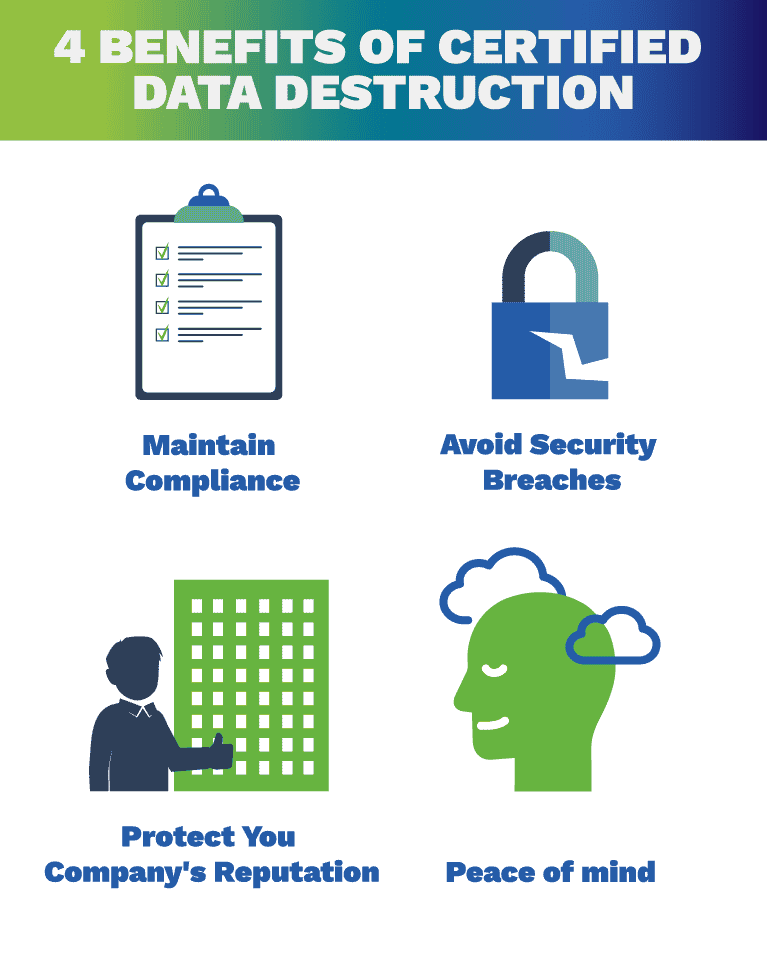Optimizing Cyber Security through Advanced Data Destruction Approaches
Optimizing Cyber Security through Advanced Data Destruction Approaches
Blog Article
The Vital Nature of Data Devastation in Upholding Computer System Protection Solutions and Protecting Against Unauthorized Gain Access To
In an era where information violations and identification theft are increasingly widespread, the significance of effective information damage can not be overstated. Numerous approaches, from data cleaning to physical devastation, offer as crucial safeguards versus unauthorized gain access to.
Importance of Information Devastation
In a progressively electronic globe, the value of data damage can not be overstated. As companies generate huge quantities of sensitive information, the potential effects of stopping working to properly dispose and manage of that information come to be significantly serious. Data breaches, identification burglary, and company espionage position substantial risks, emphasizing the necessity of effective data damage techniques.

Additionally, as technology progresses, so too do the methods through which harmful stars seek to manipulate delicate information. Organizations should remain watchful and aggressive in their information devastation strategies to protect versus these progressing dangers. By prioritizing information damage, companies not only shield their possessions yet also foster trust fund among stakeholders and customers, demonstrating a dedication to responsible information monitoring and protection methods.
Techniques of Effective Information Damage
To ensure the full and irreparable destruction of sensitive data, companies can use a range of efficient approaches customized to their certain requirements. Among the most usual methods is data wiping, which includes making use of specialized software application to overwrite existing data multiple times, making recovery practically difficult. This is especially helpful for hard disk drives and solid-state drives, where typical removal approaches are poor.
Another reliable strategy is degaussing, which makes use of solid electromagnetic fields to disrupt the magnetic domain names on storage media, making the information irretrievable. This approach is specifically matched for magnetic storage space tools, such as tape drives and tough disks.
Physical destruction is also a practical alternative, involving the shredding, crushing, or incineration of storage gadgets. This technique guarantees that information can not be recouped, making it perfect for companies managing very delicate information.

Conformity With Information Protection Regulations
Organizations need to not just concentrate on effective data destruction techniques however likewise make certain compliance with information defense laws that control just how sensitive details is dealt with and thrown away. Sticking to these policies is important for preserving and guarding individual data customer trust fund. Regulations such as the General Data Defense Policy (GDPR) in the European Union and the Medical Insurance Transportability and Accountability Act (HIPAA) in the United States enforce rigorous standards on information monitoring, which consist of needs for the safe and secure disposal of delicate details.
To achieve conformity, companies must execute thorough data devastation policies that line up with these lawful structures. This consists of determining information that requires destruction, establishing methods for safe methodsâEUR" such as shredding physical media or making use of software application that fulfills sector requirements for information wipingâEUR" and preserving comprehensive documents of devastation activities. Routine audits must be carried out to ensure adherence to these policies and to identify any type of prospective locations for improvement.
Failure to adhere to data protection guidelines can lead to substantial lawful ramifications, including hefty penalties and damage to an organization's credibility. Consequently, integrating conformity into information damage methods is not just a legal commitment however additionally an essential part of a robust information safety and security technique.
Effects of Poor Data Handling
Poor data handling can cause extreme repercussions that extend beyond instant operational problems. Organizations might face substantial monetary losses due to data violations, which frequently cause costly removal initiatives, legal fees, and regulatory fines. These monetary ramifications can strain resources and prevent growth, inevitably affecting a company's lower line.
In addition, poor data handling can badly damage a company's credibility. Partners, consumers, and stakeholders might shed rely on an entity that falls short straight from the source to protect delicate details, bring about lowered customer commitment and potential loss of company chances. This erosion of depend on can take years to restore, if it can be recovered in any way.
Furthermore, companies might deal with lawful implications emerging from non-compliance with data protection laws. Such offenses might cause fines and examinations, worsening the financial burden and further tainting the company's image.
In the realm of cybersecurity, inadequate data administration practices can produce susceptabilities that make systems more at risk to unauthorized accessibility and cyberattacks. Eventually, these repercussions highlight the essential relevance of implementing durable information taking care of procedures to guard delicate information and maintain business stability.
Finest Practices for Secure Information Disposal


Firstly, information ought to be categorized according to its level of sensitivity. Sensitive information requires extra strenuous disposal approaches, such as shredding physical papers and making use of advanced software for electronic data cleaning. Employing qualified information damage services makes sure conformity with market guidelines and standards.
Second of all, organizations must implement a data disposal policy that mandates normal audits. This plan ought to outline the procedures for data retention and destruction, ensuring that out-of-date data is disposed of without delay and safely. Educating staff members on these procedures is vital to promoting a culture of security understanding.
Finally, preserving in-depth records of disposed information enhances responsibility and provides a clear audit route. This documents should include the sort of information ruined, the technique utilized, and the day of disposal.
Final Thought
In conclusion, the critical of effective information destruction is noticeable in its role in enhancing computer safety solutions and minimizing unapproved access risks. Adopting robust methods such as data cleaning, degaussing, and physical destruction, along with conformity with policies like GDPR and HIPAA, is vital for protecting sensitive information. Overlooking proper information disposal methods can bring about find here serious effects, including data violations and legal consequences. Executing best methods in secure data disposal inevitably strengthens business integrity and customer count on.
In an era where information breaches and identification burglary are increasingly common, the value of effective data destruction can not be overstated. data destruction. Information breaches, identity theft, and corporate reconnaissance pose considerable threats, highlighting the requirement of effective More hints data devastation practices
Compliance with regulations such as GDPR and HIPAA mandates that organizations implement stringent information security actions, consisting of the safe devastation of data at the end of its lifecycle.
By prioritizing information damage, business not just safeguard their assets yet also foster trust amongst stakeholders and clients, showing a commitment to responsible data monitoring and safety practices.
Organizations must not only focus on reliable information damage approaches but also ensure conformity with information defense laws that regulate exactly how sensitive information is handled and disposed of.
Report this page